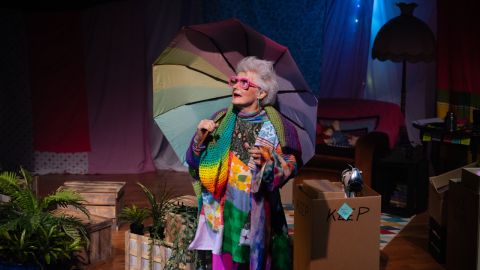A Spring Awakening for Sustainability
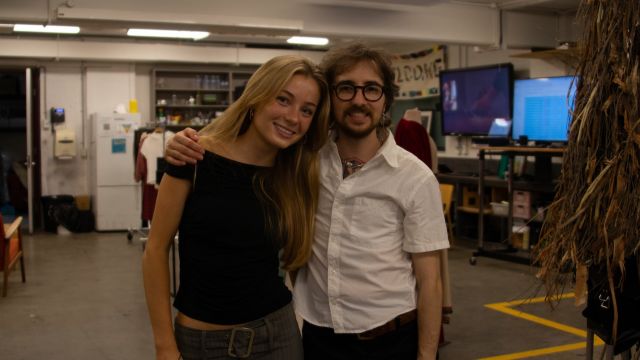
What can theatres do to lessen their impact on the planet? Designers Angelina Daniel and Edison Heartly (pictured above) chatted to NIDA’s Sustainability Manager Imogen Ross about how they built a set for writer/director Claudia Osborne’s reimagining of Spring Awakening, their graduating production in 2024, with the earth in mind.
It’s called The Theatre Green Book – a free digital resource developed in the UK which is being used to improve the sustainability of making theatre.
Angelina Daniel was inspired by a video about how the National Theatre in the UK applied the book in practice.
“As a designer who prides myself on economical and refined staging, sustainable thinking is a part of my process from the start,” Angelina said with a smile.
She used a student production of Spring Awakening as an opportunity to engage meaningfully with an environmentally conscious process. Angelina’s aesthetic choices significantly reduced waste at the conclusion of the production, lowering the carbon emissions associated with unrecyclable waste, and created valuable resources for future productions.

The vision for Spring Awakening was an ‘unfinished world’—a retelling of the 1891 classic in a stripped-back, experimental playground. Angelina explains, “Claudia and I embraced the concept of a bau-probe set, a German term for a ‘mock-up’ or rehearsal set. There’s a beauty in the imperfection of these raw spaces, where everything feels in progress, not polished. That idea shaped our aesthetic and became the backbone of our design.”
They prioritised the resourceful use of materials, using unpainted plywood flats that could be repurposed after the show, arranged like giant mosaic tiles.

The overall effect was that of an abandoned child’s playground: devoid of play equipment and colour. Audience imagination created many locations, just as children repurpose a cardboard box. Wood panelling provided familiar warmth, also provoking a deep sense of loneliness and abandonment within the void they encased. Small wooden boxes became entire rooms, a ladder became a tree, a staircase, then a hiding place, while an old, deconstructed piano became representative of ‘home’ as much as a plaything for bored character fingers. The steady arrival of bundles of dark twiggy sticks began to stack in the corner and heralded the arrival of The Stork – a surreal representation of the characters’ internal spring awakening.
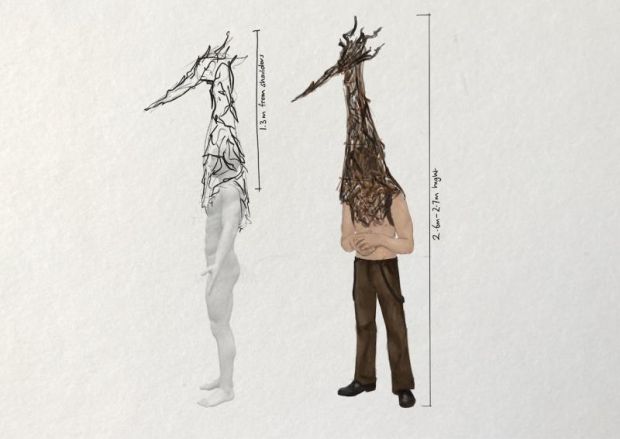 Image: stick stork costume drawing by Edison Hartley
Image: stick stork costume drawing by Edison Hartley
“The Stork was an eerie, towering figure looming over the actors like a childhood nightmare,” Edison elaborated. “It stood three metres tall, made of sticks with a beak-like protrusion for the face. The materials used for The Stork were the same sticks that the children interacted with onstage, the creature emerging from their playful imaginations.”
Resourceful thinking extended into every seam and twig of Edison’s costume designs.
“The clothes felt lived-in,” he said. “Those imperfections—the fading, the fraying—these give characters’ stories authenticity. Each piece felt like a hidden gem. It wasn’t just about sustainability wins; it was about emotional depth.”
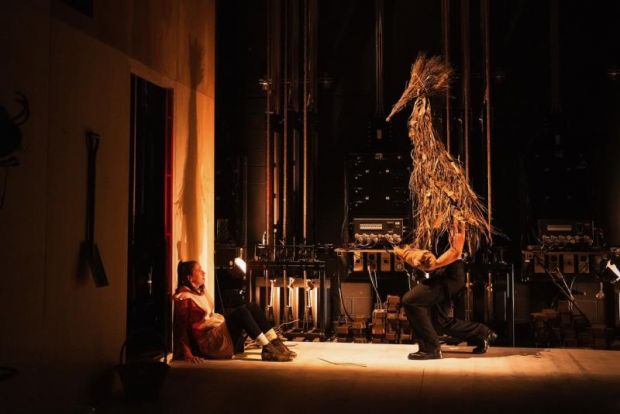
Nothing on stage went to waste. Stick bundles ended up in the organic waste bins to be turned into compost
Having support and buy-in from teachers and workshop supervisors made a huge difference to the decisions the designers could activate.
“Our Set Construction Manager actively encouraged us to think creatively about how to repurpose and deconstruct items,” Angelina said.
Edison echoed this sentiment.
“Having costume stock was invaluable. Textile waste is one of the biggest contributors to landfill globally. Having costumes at my fingertips made a huge reduction in online purchases, plastic packaging, not to mention the carbon emissions from deliveries and overseas manufacture.”
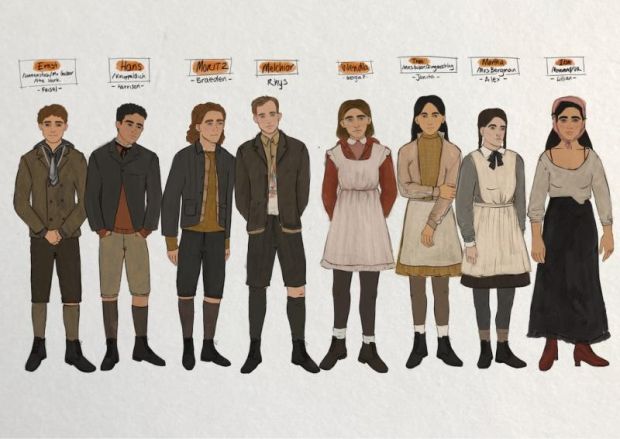 Image: Spring Awakening costume drawing 2024
Image: Spring Awakening costume drawing 2024
“Decisions start with the designer and director,” Angelina emphasized. “We have the power to shape production processes and lead this conversation. NIDA has taught me not to be too precious about my initial ideas, which is invaluable when trying to find solutions.”
Edison agreed. “This project taught me that creativity thrives within constraints. Finding more sustainable solutions pushes you to think differently, and the results are often more meaningful and rewarding.”

Production images: ©NIDA 2025, Student Production of Spring Awakening 2024. Photography by Julia Firak.
Theatre Green Book in Practice.
Angelina and Daniel’s conscious design approach was a win for the NIDA Green Plan. which was launched in 2022 and has placed sustainable goals into the heart of NIDA’s diverse curriculum. The Theatre Green Book [TGB] is used as a teaching resource across all departments, and student-led productions aim for the TGB Baseline/Basic standard, with varying degrees of success.
Divided into three volumes (Sustainable Productions, Sustainable Buildings, and Sustainable Operations), The Theatre Green Book offers a step-by-step approach to reducing theatre's environmental impact by measuring, and mitigating a designer’s desires. There is an educational version for teachers and schools to implement.
Key points include:
• Using pre-existing, reclaimed and biodegradable materials as a default in set, costume and prop design.
• Designing productions with a clear plan for material reuse or recycling, aligning with circular economy principles.
• Engaging audiences, students, and practitioners in conversations about sustainability
• Fostering a culture of ecological responsibility within the industry.
TGB Basic standard asks a production to limit its new or unrecyclable products to 50% of the show’s needs, and then to ensure that 65% of everything used in the production process is rehomed, re-used or recycled. Spring Awakening exceeded the Basic standard, achieving the TGB Intermediate standard in both sets and costumes – an excellent achievement for the company.
TGB offers a powerful reminder to all of us in stage and screen that the future of visual storytelling lies not just in imagination and creativity but in taking collective responsibility for each decision we make.
In Angelina’s last words to me, “Is a small detail worth ruining the planet for? Often, the answer is No. With enough ingenuity, the alternative solutions can be even better than what you first imagined.”
Download the guide at this link. https://theatregreenbook.com/




